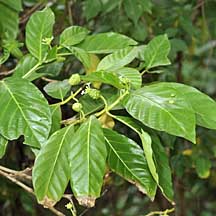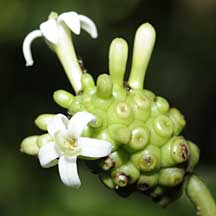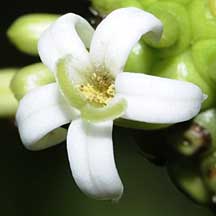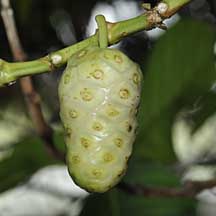 |
|
|
plants text index | photo
index
|
| coastal plants |
| Noni
or
Mengkudu Morinda citrifolia Family Rubiaceae updated Jan 13 Where seen? This strange plant is sometimes seen especially in areas where kampongs (villages) used to be. With shiny leaves and bizarre flowers and odd smelly fruits, it has an amazing variety of traditional uses. According to Giesen, it is tolerant of a wide range of habitats from wet to dry, poor to rich soils and can be found up to an altitude of 300m. In the wild, it is commonly found along the coast, including rocky shores and the back mangroves. It was possibly originally native to South Asia and northern Australia but is now found throughout the tropics and is particularly common in the Pacific Islands. According to Corners, it was possibly wild on rocky shores and was common in all villages in Malaya, frequently on the sea coasts. Features: May grow into a small tree 3-10m tall, but those on our shores usually much shorter and often just shrubs. Bark pale greyish-brown, shallowly fissured. Leaves eye-shaped large (10-40cm long) dark green, glossy, arranged opposite one another. Flowers small (1cm long) white, tubular emerging from an egg-shaped structure. Fruits egg-shaped (8-10cm), described by Burkill as "greyish transparent white, in appearance anything but appetizing, in flavour as of soap and sugar mixed, with a smell like decaying cheese". The ripe fruit rots readily and the smell has been described as a "terrible stench" that resembles vomit. The fruit contains many seeds. Role in the habitat: According to Giesen, it is often infested by Weaver ants (Oecophylla smaragdina) which build their nests out of the large leaves of the plant. Human uses: According to Burkill, the Morinda species are cultivated for the dyes produced by the root bark: shades of red, purple and chocolate. In Java, M. citrifolia was cultivated for this purpose (to produce yellow to deep orange) but not in the Malay peninsula. Medicinally, the fruit was used for a wide range of ailments including diabetes and coughs. Heated leaves may be applied to the chest for coughs. According to Wee, in Chinese medicine and in Japan it was used to contain fever and as a tonic. According to Giesen, it produces a timber with a fine and even texture. The fruits may be eaten in rojak in Indonesia, and as a staple in some Pacific Islands where they are eaten raw or cooked. The fruits may also be fed to pigs. Young leaves may be eaten as a vegetable and contain high levels of protein. Seeds may also be roasted and eaten. |
 Pulau Ubin, Jan 09  Sungei Buloh Wetland Reserve, Mar 09   Ripening fruit. Pulau Ubin, Jan 09 |
Noni on Singapore shores
| Photos for free download from wildsingapore flickr |
|
Links
References
|
|
|